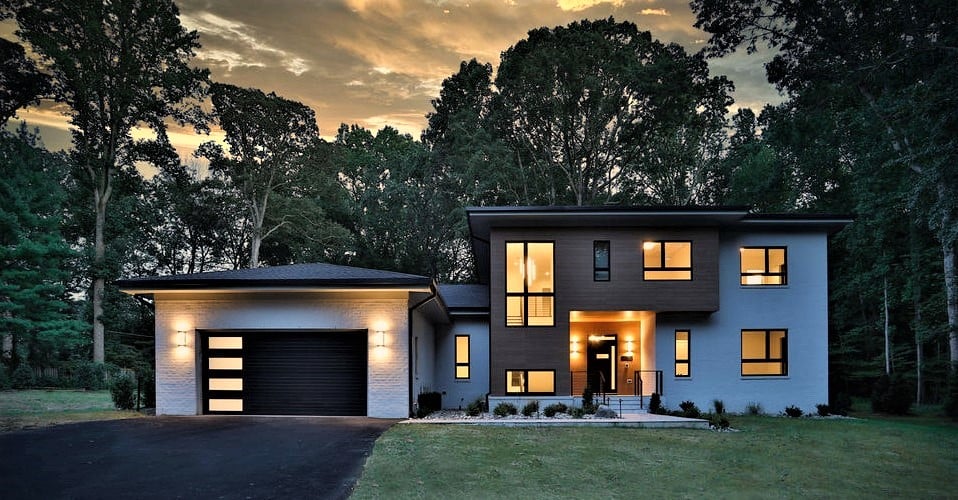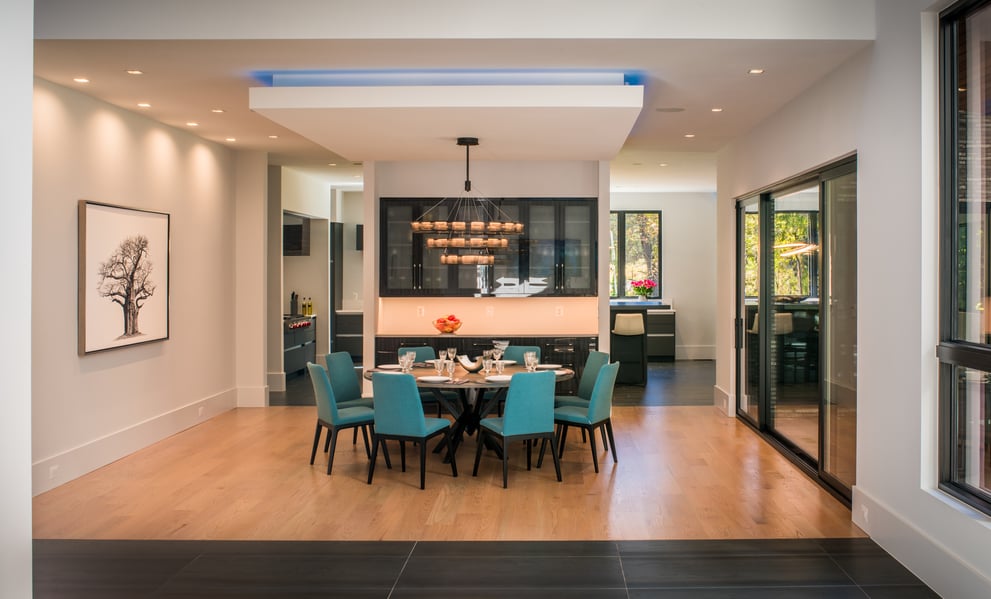Integrating Smart Home and Security Systems into Your Custom Home
August 14th, 2024
5 min. read
By Sofia Alonso

When designing a custom home, you have a unique opportunity to consider how to integrate smart home and security systems effectively into your new home. In today's digital age, these systems not only provide convenience but also offer peace of mind by ensuring that your home is secure and that you can monitor and control various elements from anywhere. Whether you're concerned about security, managing your home's systems remotely, or simply creating a more comfortable living environment, incorporating smart technologies and security measures into your custom home can significantly enhance your lifestyle.
6 Smart Home Features You Should Consider Planning into Your New Home
1. The Importance of Hardwiring Your Security System
As you begin the journey of designing and building your custom home, one of the key decisions you'll need to make is how to install your security system. While you can always wait until after your home is completed to install a Wi-Fi-based security system, it's essential to recognize that these systems are more vulnerable to interception. Wi-Fi signals can be hacked, disrupted, or even disabled, which could compromise your home’s security.
Hardwiring your security system, on the other hand, offers a more secure and reliable solution. Hardwired systems are directly connected to your home’s power supply and communication lines, making them less susceptible to interference and hacking. Moreover, they are typically more robust, providing consistent performance without the risk of Wi-Fi signal drops.
The best time to prepare for a hardwired security system is during the design phase of your home. This allows for the seamless integration of wires and sensors within the walls, avoiding the need for unsightly retrofitting later on. By planning ahead, you can save time and money in the future having to make holes all around your new home.
2. Incorporating Smart Lighting for Security and Convenience
Smart lighting is one of the most versatile and beneficial features you can integrate into your custom home. Not only does it enhance the aesthetic appeal of your home, but it also plays a crucial role in security and convenience.
With smart lighting, you can customize different lighting scenes throughout your home. For instance, you can schedule certain lights to turn on and off at specific times, making it appear as though someone is home even when you’re away. This can be a powerful deterrent to potential intruders who often target homes that appear unoccupied.
Moreover, smart lighting allows you to control your lights remotely from your smartphone. If you’re coming home late, you can turn on the lights before you arrive, ensuring that you walk into a well-lit and welcoming environment. This feature is particularly useful in larger homes, where managing the many spread out light switches can be cumbersome.
In addition to interior lighting, smart lighting can be used to illuminate the exterior of your home. Motion-activated lights can be installed around the perimeter, providing visibility and deterring anyone who might approach your property. By strategically placing these lights near entry points and pathways, you enhance both the security and the safety of your home.

3. Smart Locks: The Future of Home Security
Traditional locks have long been the standard for securing doors, but smart locks offer a new level of convenience and security. With smart locks, you can lock and unlock doors from your phone, allowing you to grant access to visitors or service providers remotely. This can be particularly useful if you need to let someone into your home while you’re not there.
Smart locks also provide keyless entry via a code, eliminating the need for physical keys that can be lost or stolen. You can easily change the access code if you suspect that it has been compromised, ensuring that your home remains secure.
Furthermore, smart locks often come with features that allow you to track who enters and exits your home. This can be particularly valuable for monitoring the comings and goings of children, housekeepers, or contractors. By keeping a log of these activities, you gain greater control and oversight over who has access to your home.

4. Strategic Door Placement and Security Measures
When it comes to securing your home, doors are one of the most critical access points to consider. While they are essential for entry and exit, each door also represents a potential vulnerability. Therefore, it's crucial to be strategic about the number of doors you include in your home design and their placement.
Only install doors where they are genuinely necessary, such as the main entrance, garage, and perhaps a back or side door depending on the size and layout of your home. Limiting the number of doors reduces the number of potential entry points for intruders and the number of doors you have to remember to lock up each night. Additionally, it’s important to secure these doors with sensors that can detect when they are opened or tampered with. These sensors should be hardwired into your security system for maximum reliability.
For enhanced security, consider using high-quality doors with reinforced frames and deadbolts. These physical barriers can make it more difficult for intruders to gain entry. Additionally, placing cameras near all doors provides an added layer of security, allowing you to monitor and record any activity around these critical access points.
5. Enhancing Window Security
Windows, much like doors, are another potential vulnerability in any home. While traditional windows can often be forced open or broken to gain entry, at AV Architects + Builders, we use window casings that cannot be opened from the outside. This design feature significantly enhances your home’s security by making it more difficult for intruders to access your home through the windows.
However, to further bolster window security, it’s advisable to install glass-breaking sensors inside your home. These sensors are designed to detect the sound of breaking glass, triggering an alarm if a window is shattered. By combining secure windows with glass-breaking sensors, you create a multi-layered defense that can deter and detect intrusions more effectively.
6. Motion Sensors: An Extra Layer of Protection
Motion sensors are an essential component of any comprehensive security system. These devices detect movement within a specific area, triggering an alarm if unauthorized motion is detected. Motion sensors are particularly useful for detecting intruders who may have bypassed other security measures, such as door or window sensors.
In addition to being placed outside the home to monitor the perimeter, motion sensors can also be installed inside the home to cover critical areas such as hallways, staircases, and living spaces. If someone manages to gain entry without triggering the alarm, the motion sensors can still detect their presence and alert you.
Motion sensors can be configured to activate only when you’re not home, ensuring that they don’t go off accidentally when you or your family are moving around the house. This flexibility makes them a practical and effective addition to your home security system.
Smart Safety Features for Every Home
Enhance the safety of your home by monitoring for potential hazards such as fires, carbon monoxide leaks, and water damage.
1. Smoke Detectors and Carbon Monoxide Detectors: Traditional smoke detectors and carbon monoxide detectors are essential safety devices, but smart versions of these detectors take safety to the next level. Smart detectors can send alerts directly to your phone, ensuring that you’re notified of any danger even when you’re not home. This allows you to take immediate action, whether that’s calling the fire department or evacuating the premises.
2. Water Leak Detectors: Water damage can be devastating, especially if it goes unnoticed for an extended period. Smart water leak detectors are designed to detect even small amounts of moisture and alert you to potential leaks. These devices can be placed near water heaters, sump pumps, air handlers, and washing machines—areas that are prone to leaks. If a leak is detected, you’ll receive a text message or alert on your phone, allowing you to address the issue before it becomes a significant problem.
3. Remote Water Main Control: One of the most powerful smart home safety features available is the ability to control your water main remotely. With a smart water main device, you can shut off the water supply to your home from anywhere, preventing further damage in the event of a major leak. This feature is particularly valuable when you’re out of town and unable to respond to a leak in person.
Building a Secure and Smart Custom Home
Integrating smart home and security systems into your custom home is an investment in both convenience and peace of mind. By hardwiring your security system, strategically placing doors and windows, and incorporating smart lighting, locks, and sensors, you can create a home that is both safe and adaptable to your lifestyle. Additionally, the inclusion of smart safety features such as smoke detectors, carbon monoxide detectors, and water leak detectors ensures that your home is protected against a range of potential hazards.
At AV Architects + Builders, we understand the importance of these technologies and are committed to helping you design and build a home that meets your security and safety needs. By planning and integrating these systems during the construction process, we ensure that your custom home is not only beautiful but also secure and future-ready.
Sofia Alonso is currently the Content Manager at AV Architects + Builders, a family-owned architect-led design-build firm specializing in creating modern style homes for clients in Northern Virginia. Having been with the company since 2019, Sofia has demonstrated a strong commitment to the firm's ethos of providing high-end, luxury living experiences. Sofia holds a Bachelor of Science in Interdisciplinary Studies with a focus on Writing from the University of Virginia. With Sofia contributing to the firm's content strategy, clients can look forward to insightful, educational content that perfectly aligns with the luxurious, high-quality living experiences that AV Architects + Builders is renowned for.
Topics:



